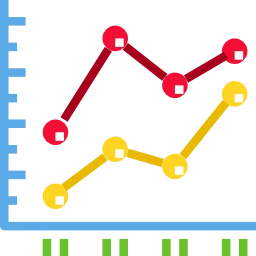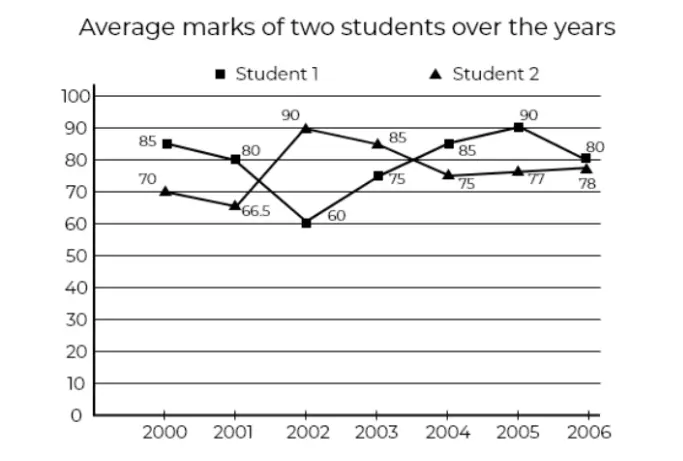PREPINSTA PRIME
Tips and Tricks and Shortcuts To Solve Line Charts Questions
Tips and Tricks for Line Chart
Here , In this page you will learn about Tips, Tricks and shortcuts for Line Chart. Along with some tricks and some important points. You will get to solve some of the questions.

Here , In this page Tips and Tricks for Line Chart is given.
Tips and Tricks for Line Chart :
- Read the questions along with the instruction carefully.
- Understand and analyze the data given in Line Graph carefully.
- Understand the usage of Percentage to Fraction Conversion.
- Try to avoid unnecessary calculation .
- Do not assume anything other than data provided.
- When it comes to long addition , subtraction , multiplication and division, discover your own method to arrive at the answer in the minimum time.
- Clear the fundamentals of DI. DI questions are based on Averages , Percentage and Ratio and Proportion concepts .
Tips and Tricks for line chart :
- Slope (m) of the Line: The slope of the line connecting two data points (x1, y1) and (x2, y2) can be calculated using the following formula:
m = (y2 -y1 / (x2 – x1).
This formula represents the rate of change between the two data points and indicates whether the data is increasing or decreasing. - Equation of a Straight Line: The equation of a straight line in the slope-intercept form is commonly used to represent a line on a line chart:
y = m(x) + b- y is the dependent variable (vertical position).
- x is the independent variable (horizontal position).
- m is the slope of the line.
- b is the y-intercept, representing the value of y when x is zero.
This equation can be used to calculate the y-values for any given x-values along the line.
- Interpolation: Line charts often use interpolation to estimate y-values for x-values that fall between two data points. Interpolation is typically done linearly, assuming a constant rate of change between data points.
- Plotting Data Points: To create a line chart, you plot the data points on the graph with x-values on the x-axis and corresponding y-values on the y-axis. Then, connect these points with straight line segments.
- Labeling and Scaling: Properly label the x-axis and y-axis with appropriate titles and units. Ensure that the scale of the axes is chosen to clearly represent the data and trends.
To know how to make a line Line Chart step by step, Click Here.
- Read the questions along with the instruction carefully.
- Understand and analyze the data given in Line Graph carefully.
- Understand the usage of Percentage to Fraction Conversion.
- Try to avoid unnecessary calculation .
- Do not assume anything other than data provided.
- When it comes to long addition , subtraction , multiplication and division, discover your own method to arrive at the answer in the minimum time.
- Clear the fundamentals of DI. DI questions are based on Averages , Percentage and Ratio and Proportion concepts .
Prime Course Trailer
Related Banners
Get PrepInsta Prime & get Access to all 200+ courses offered by PrepInsta in One Subscription
Questions and Answers for line Chart

Question 1.
What percent is student 1’s average marks to that of student 2’s average marks in the 4th year
A. 88.2
B. 85.6
C. 90
D. 87.6
Answer : 88.2
Explanation :
In 2003, Student 1 = 75
Student 2 = 85
Required % = 75/85 * 100 = 88.2
Question 2 :
What is the ratio of the average marks of Student 1 over the years to that of Student 2?
A. 79.2 : 773
B. 792 : 773
C. 79 : 77
D. None of these
Answer : 792 : 773
Explanation :
Average marks of student 1 = (85 + 80 + 60 + 75 + 85 + 90 + 80)/7 = 79.2
Average marks of student 2 = (70 + 66.5 + 90 + 85 + 75+ 77 + 78)/7 = 77.3
Ratio = 79.2 : 77.3
Question 3 :
In which of the following years is the total marks maximum?
A. 2006
B. 2001
C. 2003
D. 2000
Answer : 2000
Explanation
Quicker Method: Since the number of subjects are the same, the total marks would be higher in the year whose average marks is the highest. Hence, 2000
Question 4 :
What would be the ratio of Student 1’s total average marks of the first and the last year to Student 2’s difference of marks in the first and last year
A. 9 : 10
B. 165 : 8
C. 8 : 165
D. 1
Answer : 165:8
Explanation :
Student 1’s total marks in 1st and last year = 85 + 80 = 165
Student 2’s difference in marks in 2st and last year = 78 – 70 = 8
Ratio = 165 : 8
Question 5 :
In which of the following years was the investment minimum for company B?
In which of the year the total marks is minimum for Student 2
A. 2004
B. 2005
C. 2003
D. 2002
Answer : 2004
Explanation :
Quicker Method: Since the number of subjects are the same, the total marks would be minimum in the year whose average marks is the lowest. Hence, 2004
Get over 200+ course One Subscription
Courses like AI/ML, Cloud Computing, Ethical Hacking, C, C++, Java, Python, DSA (All Languages), Competitive Coding (All Languages), TCS, Infosys, Wipro, Amazon, DBMS, SQL and others

Series
- Line Charts – Questions Formulas | How to Solve Quickly | Tricks & Shortcuts
- Pie Charts – Questions | Formulas | How to Solve Quickly | Tricks & Shortcuts
- Bar Charts – Questions | Formulas | How to Solve Quickly | Tricks & Shortcuts
- Radar Charts – Questions | Formulas | How to Solve Quickly | Tricks & Shortcuts

Series
- Pie Charts –
Questions |
Formulas |
How to Solve Quickly |
Tricks & Shortcuts - Bar Charts –
Questions |
Formulas |
How to Solve Quickly |
Tricks & Shortcuts - Radar Charts –
Questions |
Formulas |
How to Solve Quickly |
Tricks & Shortcuts

 Apply For Jobs
Apply For Jobs Get Hiring Updates
Get Hiring Updates



Login/Signup to comment